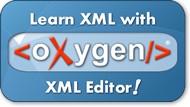SOAP Header Element


The SOAP Header element contains header information.
The SOAP Header Element
The optional SOAP Header element contains application-specific information (like authentication, payment, etc)
about the SOAP message.
If the Header element is present, it must be the first child element of the Envelope element.
Note: All immediate child elements of the Header element must be namespace-qualified.
<?xml version="1.0"?>
<soap:Envelope
xmlns:soap="http://www.w3.org/2001/12/soap-envelope"
soap:encodingStyle="http://www.w3.org/2001/12/soap-encoding">
<soap:Header>
<m:Trans xmlns:m="http://www.w3schools.com/transaction/"
soap:mustUnderstand="1">234
</m:Trans>
</soap:Header>
...
...
</soap:Envelope>
|
The example above contains a header with a "Trans" element, a "mustUnderstand"
attribute with a value of 1, and a value of 234.
SOAP defines three attributes in the default namespace
("http://www.w3.org/2001/12/soap-envelope"). These attributes are: mustUnderstand,
actor, and encodingStyle.
The attributes defined in the SOAP Header defines how a recipient should
process the SOAP message.
The mustUnderstand Attribute
The SOAP mustUnderstand attribute can be used to indicate whether a header
entry is mandatory or optional for the recipient to process.
If you add mustUnderstand="1" to a child element of the Header element it
indicates that the receiver processing the Header must recognize the element. If
the receiver does not recognize the element it will fail when processing the Header.
Syntax
soap:mustUnderstand="0|1"
|
Example
<?xml version="1.0"?>
<soap:Envelope
xmlns:soap="http://www.w3.org/2001/12/soap-envelope"
soap:encodingStyle="http://www.w3.org/2001/12/soap-encoding">
<soap:Header>
<m:Trans xmlns:m="http://www.w3schools.com/transaction/"
soap:mustUnderstand="1">234
</m:Trans>
</soap:Header>
...
...
</soap:Envelope>
|
The actor Attribute
A SOAP message may travel from a sender to a receiver by passing different
endpoints along the message path. However, not all parts of a SOAP message may be intended for the ultimate
endpoint, instead, it may be intended for one or more of the endpoints on the message path.
The SOAP actor attribute is used to address the Header element to a specific endpoint.
Syntax
Example
<?xml version="1.0"?>
<soap:Envelope
xmlns:soap="http://www.w3.org/2001/12/soap-envelope"
soap:encodingStyle="http://www.w3.org/2001/12/soap-encoding">
<soap:Header>
<m:Trans xmlns:m="http://www.w3schools.com/transaction/"
soap:actor="http://www.w3schools.com/appml/">234
</m:Trans>
</soap:Header>
...
...
</soap:Envelope>
|
The encodingStyle Attribute
The encodingStyle attribute is used to define the data types used in the
document. This attribute may appear on any SOAP element, and it will apply to that
element's contents and all child elements.
A SOAP message has no default encoding.
Syntax


Learn XML with <oXygen/> XML Editor - Free Trial!
 |
|
oXygen helps you learn to define,
edit, validate and transform XML documents. Supported technologies include XML Schema,
DTD, Relax NG, XSLT, XPath, XQuery, CSS.
Understand in no time how XSLT and XQuery work by using the intuitive oXygen debugger!
Do you have any XML related questions? Get free answers from the oXygen
XML forum
and from the video
demonstrations.
Download a FREE 30-day trial today!
|
|